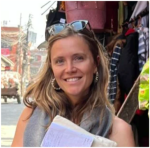
The European market potential for honeymoon tourism
The tour operator market for honeymoon tourism in Europe is large and lucrative. Honeymoons are very varied. Beach honeymoons are the most popular, but multi-centre honeymoons, mini-holidays and adventure honeymoons are becoming more popular. Gen Y, Gen Z and LGBTQ+ are important target groups for honeymoon tourism. Personal service and luxury are key characteristics. Germany, France and the UK are the largest European markets, followed by Italy, Spain and Poland.
Contents of this page
1. Product description
A honeymoon is a holiday that couples take after they get married. Couples usually leave for their honeymoon straight after their wedding, or a day or two later, depending on where they go. Honeymoons enable newlyweds to celebrate their marriage, religious or civil, and are regarded as the start of a new chapter in their lives together. Honeymoons can be restful or adventurous, to coasts or in the countryside, depending upon the couple.
There are many important characteristics of honeymoon tourism:
- They contribute a lot to the economy because honeymooners spend more than other holidaymakers.
- Couples spend more time planning their honeymoon than other holidays, often at least eight months.
- Destinations vary widely, but Europeans often choose long-haul destinations. As a result, honeymoon activities are also very varied.
- The young dominate the honeymoon market, but second marriages and those marrying later in life also want weddings and honeymoons.
- Service expectations are very high because of the honeymooning couple’s strong emotions. A honeymoon can be one of the most important trips a couple can take, so creating something memorable is important.
Many activities and experiences can be added to create a honeymoon. The market is dominated by tour operators who tailor honeymoons to couples’ desires. They can combine anything couples want to do and afford. Some couples prefer to create their honeymoon independently. Others may use tour operators for some parts of their honeymoon.
Table 1: Examples of honeymoon types
| Types of Honeymoon | Description |
Beach honeymoon | The honeymoon is focused on the beach as the main destination. These holidays are usually in destinations known for their white, sandy beaches, sparkling seas and blue skies. Long-haul destinations are very popular for beach honeymoons. They are the most popular kind of honeymoon. |
Spa honeymoon | Like beach honeymoons, spa honeymoons are popular. They are often in luxury resorts that offer a wide range of treatments. They are frequently located in beach destinations or tranquil, lush surroundings in tropical places. |
All-inclusive honeymoon | All-inclusive honeymoons are where everything is paid for upfront. The benefits for the honeymooners are that there are no worries about hidden or added costs. All-inclusive honeymoons are usually in resorts with luxury accommodation, quality dining options and a range of land and water activities all included in the price. |
Minimoon | Minimoons are shorter in duration than traditional honeymoons. They are increasingly popular among couples with smaller budgets or less time. They may also be used as a ‘stopgap’ before a longer honeymoon later. |
Multi-centre honeymoon | A multi-centre honeymoon may involve a stopover at a city or another destination before moving on to a second destination. Cities and beaches are a common combination. |
Citymoon | A citymoon’s focus is on exploring an urban destination with a vibrant culture and exciting attractions to discover. |
Safari honeymoon | Safari honeymoons provide an unforgettable adventure, usually in one of Africa’s game reserves or national parks. They are popular for couples seeking something different. Many couples combine a safari with a beach honeymoon. South Africa, Mauritius and the Seychelles offer this combination. |
Ski honeymoon | Mountain vistas and skiing make for an excellent honeymoon experience for those who love the sport. |
LGBTQ+ honeymoon | LGBTQ+ honeymoons are arranged by specialists who understand their needs. This group has different needs from other groups; namely tolerance, respect and safety. They only travel to destinations where they can be assured of acceptance. |
Honeymoon cruise | Taking a cruise as a honeymoon offers opportunities to explore several places, which can create a memorable experience. |
Adventure honeymoon | Adventure honeymoons are gaining popularity as adventure tourism appeals to markets seeking adventure and immersion. They involve different adventures in remote, off-the-beaten-track destinations. They can include anything considered adventurous, such as hiking, cycling, safari, diving, community-based tourism (CBT) and high-adrenaline sports like paragliding and kitesurfing. |
Source: Acorn Tourism Consulting, 2024
There are very few standard honeymoon products. The honeymoon market demands high levels of personalisation. Tour operators generally post itinerary ideas on their websites to attract potential customers. Couples are encouraged to engage with operators directly to plan exactly what they want. Some operators offer video call appointments. Examples of honeymoons in popular honeymoon destinations are given below.
- Hanging Gardens of Bali. This resort offers a range of honeymoon packages (seven days and six nights, four days, three nights). Honeymoon specials include the honeymoon set up and gifts, a romantic dinner under the stars, a 90-minute couples massage, a bottle of champagne and sunset cocktails.
- Constance Hotels & Resorts in Mauritius, Seychelles, Maldives and Madagascar. Romance is fostered through a dinner under the stars, a movie on the beach and romantic luxury rooms. The resorts also offer diving, spa and golf.
- Cape and Safari Honeymoon, South Africa. This trip includes safaris to see the Big 5 in the Timbavati and Sabi Sands private game reserves. Accommodation is in some of the most luxurious camps and a waterfront hotel in Cape Town. The trip is specifically made for honeymooners.
- The Jade Mountain Resort, St Lucia, Caribbean. The Total Romance package is all-inclusive and offers spa treatments and other resort activities. There are several packages available for this resort. A ‘fifth night free’ is also offered as part of this package, and couples staying a minimum of seven nights can have their seventh night free as part of the ‘Lovers Early Bird Total Romance” package.
INSIGHT: How does a destination wedding relate to a honeymoon?
Destination weddings are weddings that take place in a location away from the couple’s hometown. Typically, they involve the couple, their families and a group of friends who travel to a special location to celebrate the wedding. Many couples have destination weddings abroad. For European couples, other European are most popular, particularly countries like France, Italy and Greece.
Developing countries are also popular locations, including Mexico, South Africa, Caribbean nations (e.g. Jamaica and the Virgin Islands), Bali and the three island nations in the Indian Ocean (Mauritius, Maldives, and Seychelles). They are also popular honeymoon destinations. Couples that choose long-haul destinations are likely to have their honeymoons there too.
The destination wedding market is related to the honeymoon tourism market, but both can exist without the other.
Figure 1: Beach destinations are popular for destination weddings
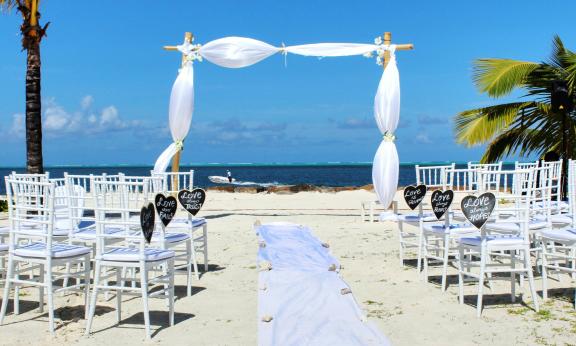
Source: Arshad Pooloo at Unsplash , 2018
Destination weddings account for about 17% of the global wedding market, valued at $178.5 billion (USD) in 2022. Luxury hotels and resorts dominate the market as venues for destination weddings. Weddings can last up to a week. Hotels and resorts often work with local wedding planners who themselves team up with wedding service providers. These collaborations help to increase the reach of wedding services. This gives wedding couples choice and expertise. Wedding packages are common, and they provide all the essential services they need, including the legal requirements.
You should understand that destination wedding services generally involve practical things. These can include flowers, food and drink, organising the service, preparing the music, personal services like hair and make-up and arranging legal aspects. Look at this Romance Package as an example of what is included in a wedding package. Trips and tours are not usually included in a single package. Some couples may want to add them to a package, but this will depend entirely on the couple’s preferences.
As mentioned, many couples who choose destination wedding will go on to have their honeymoon in the same country. This is a more cost-effective way of controlling a budget and requires less travelling time. It is also more sustainable, which is becoming increasingly important.
Tips:
- Identify the resorts and hotels that offer destination weddings in your region. Approach the wedding planners they work with to see if you can become a trusted supplier.
- Check which Destination Management Companies (DMCs) provide tourism services to event planners. Contact them to see what you need to do to become a trusted supplier.
End market segmentation and consumer behaviour
The honeymoon market is broad, as people of all ages get married. As a result, honeymooners cross all the major consumer groups: Baby Boomers (1946–1964), Gen X (1965–1985), Gen Y (1986–1995) and Gen Z (1996–2021).
The two most important groups are young people and the LGBTQ+ markets.
- The honeymoon niche market is dominated by young people, specifically Gen Y and Gen Z. These generations are also eager to travel and seek unique experiences. They use tour operators and social media platforms to find inspiration and make travel decisions.
- The LGBTQ+ market is an important target group for honeymoons. Being able to travel safely and being welcomed and respected are important for this target group.
The chart below describes the characteristics of each major consumer group by budget and travel time.
Table 2: Travel Characteristics of Consumer Groups by budget and time to travel
| Demographic | Budget | Mid-Budget | Luxury | Time Rich | Time Poor |
| Gen Z | ✓ | ✓ | |||
| Millennials/Gen Y | ✓ | ✓ | ✓ | ✓ | |
| Gen X | ✓ | ✓ | ✓ | ✓ | |
| Baby Boomers | ✓ | ✓ | ✓ |
Source: Acorn Tourism Consulting, 2024
To find out more about the travel characteristics of the honeymoon target groups, read the CBI studies that focus on the opportunities to reach these markets:
- Baby Boomers, Gen X, Gen Y and Gen Z
- LGBTQ+
Accessible tourism on the European market
Accessible tourism is the ongoing effort to ensure tourist destinations, products and services are accessible to everyone, regardless of physical limitations, disabilities or age. It involves publicly and privately owned tourist locations. The improvements benefit those with permanent physical disabilities and parents with small children, elderly travellers, people with temporary injuries, such as broken legs, as well as their travel companions. Disabled tourists may travel individually, in groups, with their families or carers.
Accessibility honeymoon tourism
People going on honeymoons may have a range of accessibility needs. They may have mobility needs, sensory needs or be elderly. Europe has an ageing population, so more older European travellers may need extra support when they travel overseas. Specific things to consider are:
- If you cater to people with disabilities, state exactly what you can and cannot do in your marketing materials. Treat all consumer markets with empathy and communicate clearly.
- Make sure all facilities are suitable for people with and without disabilities. Beach holidays are popular in the honeymoon market. Think carefully about how people with disabilities can use facilities without asking for help.
- Ensure that the ground suppliers you use maintain their facilities, such as walkways, ramps and mobile lifts.
- If you use a wedding planner, make sure they know what you can provide for the disabled market. Consider what services you can offer that will set you apart from other providers so you are top of mind when planners are looking for providers.
Tip:
- Read the CBI studies The European market potential for accessible tourism, and Entering the European market for accessible tourism products for useful advice to make your tours accessible.
2. What makes Europe an interesting market for honeymoon tourism?
Europe is an interesting market for honeymoon tourism because the market for honeymoons is large, and Europe is estimated to account for 30% of the global market. Weddings and honeymoons are also popular in Europe, and newlyweds want their honeymoons to be the ‘trip of a lifetime’.
Europe is a large market for honeymoon tourism. It accounts for around 30% of the global market, after America (35%). The global honeymoon tourism sector is growing. It was valued at $125.3 billion (USD) in 2022 and is forecast to reach $179.3 billion by 2030. This represents a CAGR of 4.7% between 2023 and 2020. Increasing disposable incomes, more people getting married and the growing popularity of adventure tourism are reported drivers of global growth.
Around three-quarters of married couples have a honeymoon (72%). As people spend up to three times more on a honeymoon than on other holidays, this presents a good opportunity for local tour operators. However, excellent service and personalisation are key to meeting this market’s needs.
CBI research in 2022 in the European market showed that developing countries were more popular among honeymooners from the European source markets than other destinations. In Europe, most weddings take place between April and October when weather conditions are more favourable. Thus, the honeymoon season generally follows the same pattern as for weddings. This is a longer season than many other niches, which often follow the summer holidays.
The global honeymoon market is supported by the DWHSA (Destination Wedding and Honeymoon Specialists Association), a trade association based in North America. It is an organisation that suppliers can use to list their services. For couples, it operates the portal RomanceTravelSpecialists.com, which provides a search service for specialists.
Tips:
- Be aware that honeymooners have different needs from other niche markets. While romance may be key, service is also important. Being on a honeymoon is a very special time for newlyweds, and they want an experience they will remember for the rest of their lives.
- Remember that honeymooners spend a lot of their wedding budget on the honeymoon: up to 20%. As a result, they have high expectations for the service you offer them. Some aspects of the honeymoon market are similar to the luxury market. Read the CBI study What are the opportunities for luxury tourism from Europe for tips about the luxury market from Europe.
3. Which European countries offer the most opportunities for honeymoon tourism?
The European countries with the most marriages every year are Germany, the United Kingdom (UK), France, Italy, Spain and Poland. The number of weddings per source market is key because honeymoons are taken after weddings. Many weddings take place in Europe every year, and many tour operators serve this market.
Sources: Eurostat, Destatis, ONS, Insee, Institutio Nacional de Estadistica, 2024
The number of marriages in Europe has fluctuated for many years, but it is beginning to grow again. Over the years, marriage has become less important from a religious perspective. Many couples choose to live together instead or have a civil ceremony. In recent trends, the cost of living crisis has contributed to couples delaying their wedding until they feel more financially secure.
However, the honeymoon tourism niche is substantial. Many tour operators serve this segment, which is a clear indicator that honeymoons are extremely popular. They are also lucrative for tour operators, selling for much more than other holidays.
Germany
There were 360,979 marriages registered in Germany in 2023. This represents a fall of 7.6% between 2022 and 2023 and a decline of 3.6% a year since 2019. A further 652 civil partnerships were reported in 2023, a decrease of 24% compared to 2022. Civil partnerships are not religious ceremonies but are often regarded as ‘weddings’ by participants.
Table 3: Number of Marriages in Germany, 2023
| Marriage indicators | Number of Marriages | % Share |
| Total Marriages in Germany | 360,979 | 100% |
| Marriages of opposite-sex couples | 351,751 | 97% |
| Marriages between same-sex couples | 9,228 | 3% |
| One spouse is an international | 41,662 | 12% |
| Civil partnerships | 652 | N/A |
Source: Federal Statistical Office (Destatis), 2024
Germans are big honeymooners and prefer to take long honeymoons. 45% plan one or two-week trips, while 29% take longer trips of three weeks or more. Only 7% take shorter honeymoons (minimoon) over extended weekends.
Source: Statista, 2024
Most large German tour operators, like TUI, FTI and DERTOUR, have honeymoon sections in their itineraries. Other general tour operators, like Galeria and Lotus Travel, also have honeymoons as a theme. Honeymoon Travel is a specialist honeymoon provider.
Like most European source markets, the internet is an important source of inspiration, as with blogs like Petit Chapeau and Fräulein K Sagt Ja. Wedding magazines usually have sections on honeymoons, like Braut and Hochzeitsferien.
German newlyweds choose from a variety of long-haul honeymoon destinations, including the Maldives, Mauritius, the Seychelles and Bali. Jamaica and the Dominican Republic are also popular.
United Kingdom
There were 246,897 marriages in England and Wales in 2022, a 20% increase from 2021. This indicates that number of marriages in the UK have recovered to pre-pandemic levels.
Table 4: Number of Marriages in England and Wales, 2023
| Marriage indicators | Number of Marriages | % Share |
| Total Marriages in England and Wales | 246,897 | 100% |
| Marriages of opposite-sex couples | 239,097 | 97% |
| Marriages of same-sex couples | 7,800 | 3% |
Source: ONS, 2024
The average amount British couples spent on honeymoons was £4,270 in 2022, up from £3,384 in 2021. Honeymoon costs account for 17.5% of the average wedding costs, which is a substantial margin. Couples are most likely to spend more on the honeymoon than anything else, including the venue and the dress.
As with much of Europe, the spring and summer months are the most popular for weddings and thus for honeymoons. August is the most popular month (15.5% of weddings in the UK), followed by July (15%), June (14%) and September (13%).
Source: Hitched, 2023
66% of couples planned honeymoons abroad in 2022, up from 27% in 2021. 14% had more than one honeymoon, down from 34% in 2021.
Beach honeymoons were the most popular type of honeymoon in 2022 (47%), up from 42% in 2021. Long-haul travel was the next most popular option, at 26%, up from 24% in 2021. Island destinations are also popular (24%).
Source: Bridebook, 2022
Online marketing for honeymoons is widespread in the UK. Weddings and Honeymoons Magazine is the main publication on the UK market. World Wide Honeymoon is a blog about planning honeymoons. There is also a series of podcasts on the website. Brides travel bloggers for inspiration, such as JetSetChristina, Traveler’s Joy and Salt in our Hair.
The tour operator market is crowded. Operators typically market honeymoons as ‘luxury’ to attract high spenders. Hitched Magazine maintains a list of the best honeymoon travel agencies in London. There are specialist honeymoon tour operators on the market, like Honeymoon Dreams. Most general tour operators have honeymoon sections, including luxury operators like Audley Travel, Kuoni and Abercrombie & Kent, which even has a ‘bucket list honeymoons’ section.
While many wedding fairs are hosted in the UK each year, they tend to focus on weddings rather than honeymoons. Consumers are more likely to visit consumer travel shows, like the Destinations Show and the Luxury Travel Fair. You can find many of the UK’s top tour operators at shows like this, and they may be interested in doing business with you.
The top honeymoon destinations for UK couples in 2021 were (in order) Maldives, Sri Lanka and Mauritius.
Figure 6: Top ten honeymoon destinations for UK couples
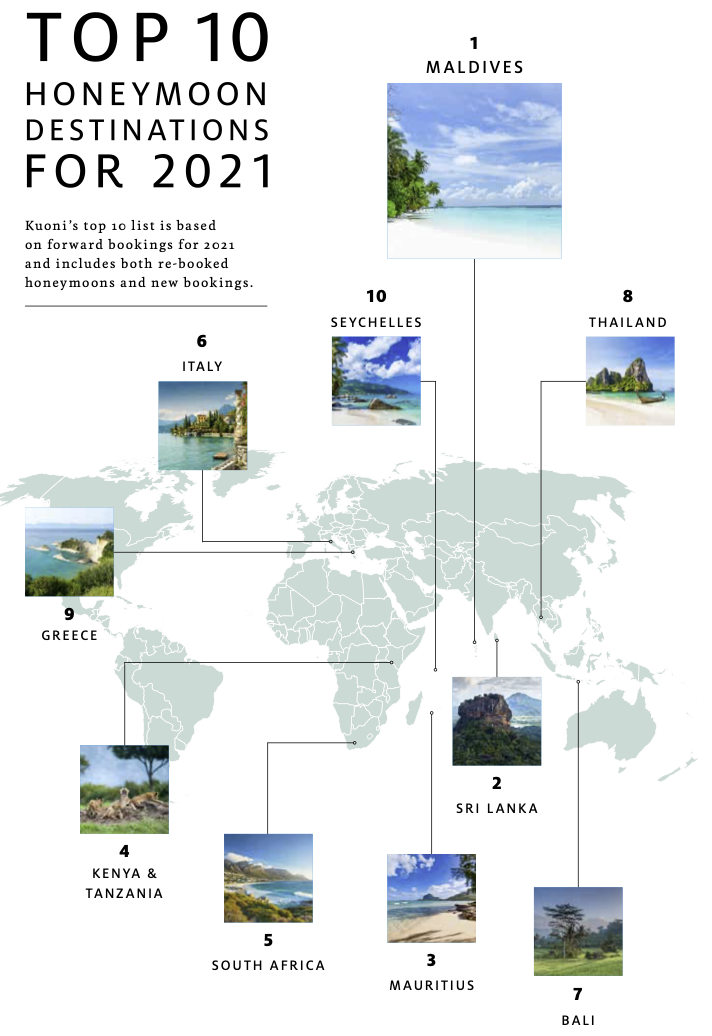
Source: Kuoni, 2021
France
There were 242,000 marriages in France in 2023, around the same as 2022. Marriages in France have been increasing recently. There are now more than before the pandemic. However, the number of civil ceremonies is similar to religious ceremonies. Both types have exceeded the pre-pandemic levels.
Table 5: Marriages in France, 2023
| Marriage indicators | Numbers of Marriages | % Share |
| Total Marriages in France | 242,000 | 100% |
| Marriages of opposite-sex couples | 234,740 | 97% |
| Marriages of same-sex couples | 7,260 | 3% |
| Pacs (Civil Solidarity Pact) | 209,827 | N/A |
Source: Insee, 2024
The average honeymoon length in France is seven days, and 80% of French newlyweds take a honeymoon. 75% of couples honeymoon within a week of their wedding. Shorter honeymoons are called ‘wedding weekends’ or ‘romantic getaways’. French couples spend €2,500–3,500 on honeymoons, or 15% of the average wedding budget. €9,950 is the average spend on luxury honeymoons, accounting for about 15% of the market. October is the most popular month for honeymoons (23%).
French tour operators that sell honeymoon tourism are either general operators that have honeymoons in their portfolios, like Havas Voyages, or specialists, like Voyage Lune de Miel and My Honeymoon. The wedding portal Mariages.net provides a useful and comprehensive honeymoon supplier list of 223 operators.
Wedding bloggers provide inspirations for French couples wanting the perfect honeymoon, including La Mariee aux Pieds Nus (The Barefoot Wedding) and Creativ Travel.
The most popular destinations for a honeymoon are:
- Mauritius (18%)
- Indonesia (9%)
- French Polynesia (8%)
- Seychelles (6%)
- Réunion, the French overseas territory island in the Indian Ocean
64% go for relaxing honeymoons. Beaches are the most popular, followed by nature. Only 30% of couples choose cities.
Italy
There were 189,140 marriages registered in Italy in 2022, an increase of 4.8% compared to 2021. Civil ceremonies have been growing in popularity. There were more civil ceremonies in 2018 (71%) than religious ceremonies (29%).
Most Italian couples get married in September (24%) and plan their weddings and honeymoons 11–12 months in advance. 82% of couples honeymoon after getting married; 53% leave immediately after the wedding. The average cost of a honeymoon abroad was reported to be €6,900. The average honeymoon length is 10–12 days. 43% of couples take their children with them. This means there are opportunities if your business is aimed at the family market.
Italians’ favourite honeymoon destinations in developing countries are: the Maldives (9%), the Caribbean (5%), Latin America (5%), Thailand and Mauritius (3% each), and the Seychelles, India, French Polynesia and Japan (2% each). A further 18% like to have multi-centre honeymoons. 6% like to cruise. South Africa and Tanzania are also popular.
Figure 7: Top honeymoon destinations for Italians, 2023
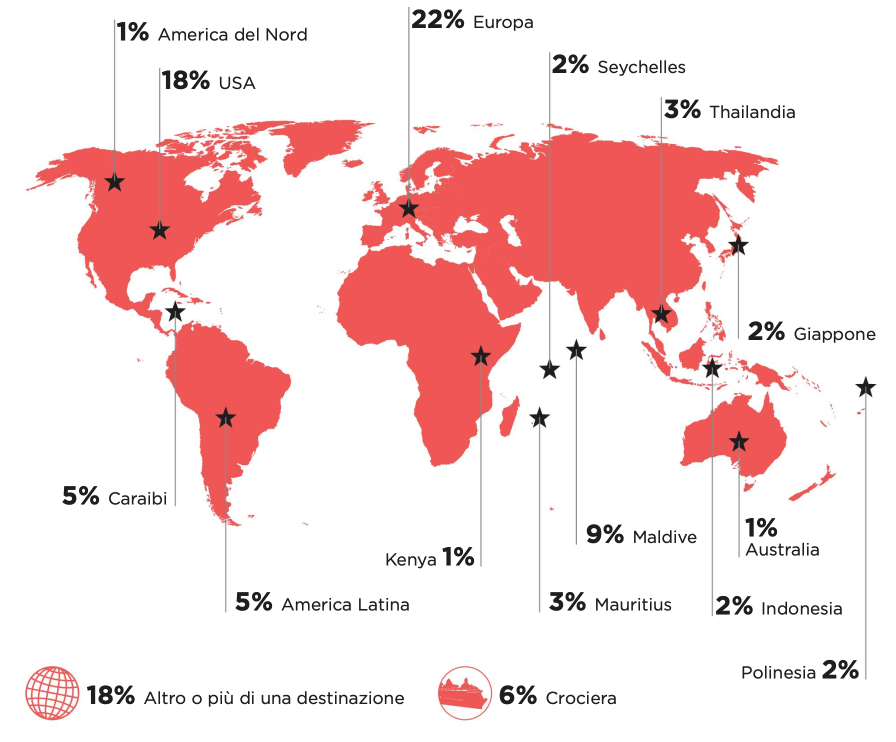
Source: The Marriage White Paper, Matrimonio.com, 2023
The tour operator market for honeymoon tourism is large in Italy. General tour operators Idee per Viaggiare and IGrandiviaggi have honeymoon sections. Operators like Turisanda specialise in selling honeymoons. Bluvacanze is one of the largest travel agencies in Italy and offers honeymoon services.
Spain
In 2022, 176,860 marriages were registered in Spain. Most were heterosexual (97%), but 3% were same-sex.
Table 6: Marriages celebrated in Spain, 2022
| Marriage indicators | 2022 | % Share | % Change from 2021 |
| Total Marriages in Spain | 179,107 | 100% | 21% |
| Marriages of opposite-sex couples | 172,871 | 97% | 20% |
| Marriages of same-sex couples | 6,236 | 3% | 23% |
| Both spouses are Spanish | 146,038 | 82% | 19% |
| One spouse is an international | 27,314 | 15% | 24% |
| Both spouses are international | 5,755 | 3% | 38% |
Source: Instituto Nacional de Estadistica, 2023
Honeymoons are a well-established tradition in Spain, and 84% of Spanish newlyweds take them. 68% leave on their honeymoons immediately after the wedding, and 75% choose an international destination.
An emerging trend in the Spanish honeymoon market is that more people are postponing their honeymoons, especially amongst wealthier groups. This is likely because seasonality in the market is less marked nowadays, and couples tend to choose the time for their honeymoon based on the best time to visit a destination.
Spanish couples allocate around 20% of their wedding budget to their honeymoons, spending an average of €6,000 on a honeymoon in an international destination. The average length of a honeymoon is 12 days. 9% of couples who have children take them. If you offer family trips, this could be an opportunity.
Many tour operators serve the honeymoon market like Atrapalo. This list of honeymoon tour operators is maintained by the marriage portal, Bodas.net.
Mexico is one of the most popular long-haul destinations for Spanish newlyweds. As a Spanish-speaking country, it is especially convenient for the Spanish market. It accounts for 3% of the market, but the region around the Riviera Maya accounts for a further 6%. Tanzania and Kenya (9%), Costa Rica (5%) and Thailand (4%) are other popular developing countries for honeymoons.
Poland
Marriages in Poland have declined after peaking in 2007. There were 155,800 marriages in 2020, which fell to 154,560 in 2022. These include religious and civil ceremonies. More Polish people today choose civil ceremonies over traditional religious services. The number of religious marriages compared to civil ceremonies is roughly equal.
Tour operators that serve the honeymoon market include LOT, Unique Moments and Traveliada. Honeymoon blogs are sources of inspiration for Polish couples, such as Wesele z Klasa, and online travel guides like Magazyn Wakacje.
Popular developing countries for Polish honeymooning couples include Bali, Indonesia, Mexico and Morocco.
Tips:
- Research the marketing platforms for honeymoons in your chosen source markets. Analyse tour operators and the destinations they recommend for honeymoons. Explore blogs and online magazines to build a picture of the honeymooner.
- Find the Destination Management Companies (DMCs) in your country and aim to become a trusted supplier. European tour operators that offer honeymoons will likely use DMCs to provide in-country trips and tours. Find out more in the CBI study Tips for doing business with European tourism buyers.
- Consider teaming up with an influencer to promote your destination as a honeymoon destination. Gen Y and Gen Z trust influencers more than traditional brands. Use the CBI study How to work with influencers to find out how they can help you reach European markets.
- Offer discounts for early bird honeymooner customers. Most couples spend months organising their weddings and honeymoons. A discount may make you an early sale.
4. Which trends offer opportunities or pose threats in the European destination wedding and honeymoon tourism market?
The main trends that affect the honeymoon tourism market are sustainability, the growing demand for unique destinations, the shift away from beaches to multi-centres and minimoons and social media’s growing influence. The desire to visit off-the-beaten-track destinations is a good opportunity for you. You should use the trends to help you develop products to attract this market.
Honeymooners have a growing interest in sustainable tourism options
More couples are choosing eco-resorts and destinations that have strong sustainability credentials. Generally, Europeans want to minimise their carbon footprints. Destinations that focus on conservation and ecolodges that protect and conserve their surrounding environment are popular amongst honeymooners. At the same time, they want to get involved with activities that directly support local initiatives, like coral preservation and tree planting.
However, they also want their travel habits to positively affect places and people. Choosing unique and authentic experiences that positively involve local communities is popular amongst sustainably minded honeymooners.
Slow-travel honeymoons are another sustainability trend. Slow travel is defined as travel that emphasises connections with local people and places, staying longer and locally, and enjoying authentic cultural experiences. This trend fits well with honeymoon tourism as couples immerse themselves in different cultures in one place, slowing down to enjoy both the location and each other’s company. After the stress and excitement of planning and hosting a wedding, a slow travel honeymoon is the perfect antidote for some couples.
There are many examples of destinations, tour operators and tourism providers that have excellent sustainability credentials from all over the world:
- Costa Rica is probably the world’s most successful eco-destination and is well-known for its national sustainability scheme: the Certification for Tourism Sustainability (CST). This Costa Rican tour operator publishes an online guide to Unforgettable eco-friendly honeymoon in Costa Rica, explaining how couples can travel sustainably on their honeymoon.
- The Brando Resort in Tetiaroa in French Polynesia exists in harmony with the local environment, people and their ancestral lands. Naturalist local guides share their history, culture and nature to create an authentic link with the surroundings. Musical celebrations provide the essence of the community’s culture.
- Playa Viva in Juluchuca, Mexico, is a luxury ecolodge resort, turtle sanctuary and permaculture farm, which is 100% off-grid. Its mission is to focus its activities on the future, so it practises regenerative tourism. Watch this video about the resort and its sustainability activities.
Increased preference for adventure in unique locations and off-the-beaten-track locations
Although beach destinations are the most popular places for honeymoons, there is an ongoing shift to more adventurous and authentic honeymoons. Gen Y and Gen Z are more inclined to seek off-the-beaten-track locations for adventures and experiences. As a key honeymoon segment, their preferences for exciting and authentic adventures are also affecting the honeymoon market.
Safari trips, hot air ballooning, exploring Machu Picchu in Peru, skiing in the Alps, trekking in the Himalayas, hiking in Patagonia and diving in the Galapagos Islands are all honeymoon adventures that appeal to this group. This creates opportunities for tour operators in remote and off-the-beaten-track places. The key to success is to offer unique experiences and exceptional service to this group.
Figure 8: Unique experiences and remote destinations are becoming more popular among honeymooners
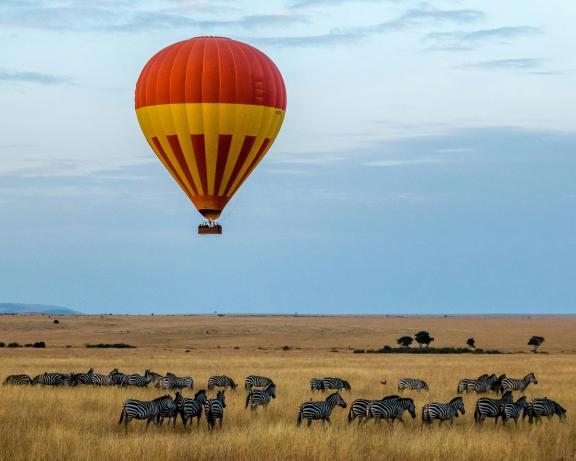
Source: Sutirta Budiman at Unsplash , 2018
Minimoons and multi-centre honeymoons are more in demand
Other ways of honeymooning are becoming more popular. Two of the most popular are minimoons and multi-centre honeymoons.
Minimoons are shorter honeymoons. They are often taken after a destination wedding. This helps the couple extend the holiday so they can spend more time with their friends and families who may have travelled a long way to be with them. Minimoons can replace traditional honeymoons or act as substitutes while the couple saves up for a larger honeymoon later on.
Multi-destination honeymoons allow couples to explore diverse landscapes and cultures in a single trip rather than spending two weeks in one place. Island hopping in the Caribbean, self-drive holidays in Europe and cross-country adventures give couples the freedom to make their own choices.
Wellness and all-inclusive luxury are other trends affecting the honeymoon market. Wellness retreats are popular among couples who want to rejuvenate after the stress of wedding planning. Spa treatments, yoga and meditation in calm and peaceful locations can help them relax and connect.
The rising influence of social media impacting the choice of destination
Social media has a major effect on the travel industry, and the honeymoon niche is particularly influenced by it. Honeymoon marketing is dominated by images of stunning destinations and beautiful scenery, designed to attract a discerning market that wants something extra special.
Numerous travel bloggers and influencers upload visually appealing content that showcases unique experiences and spectacular landscapes. Research has shown that 75% of travellers use social media for travel inspiration. Instagram, TikTok and Pinterest are the most important platforms for discovering new destinations, hidden gems and unique travel experiences. Their use continues to grow, especially among Gen Y and Gen Z.
Figure 9: Social media and its influence on travel
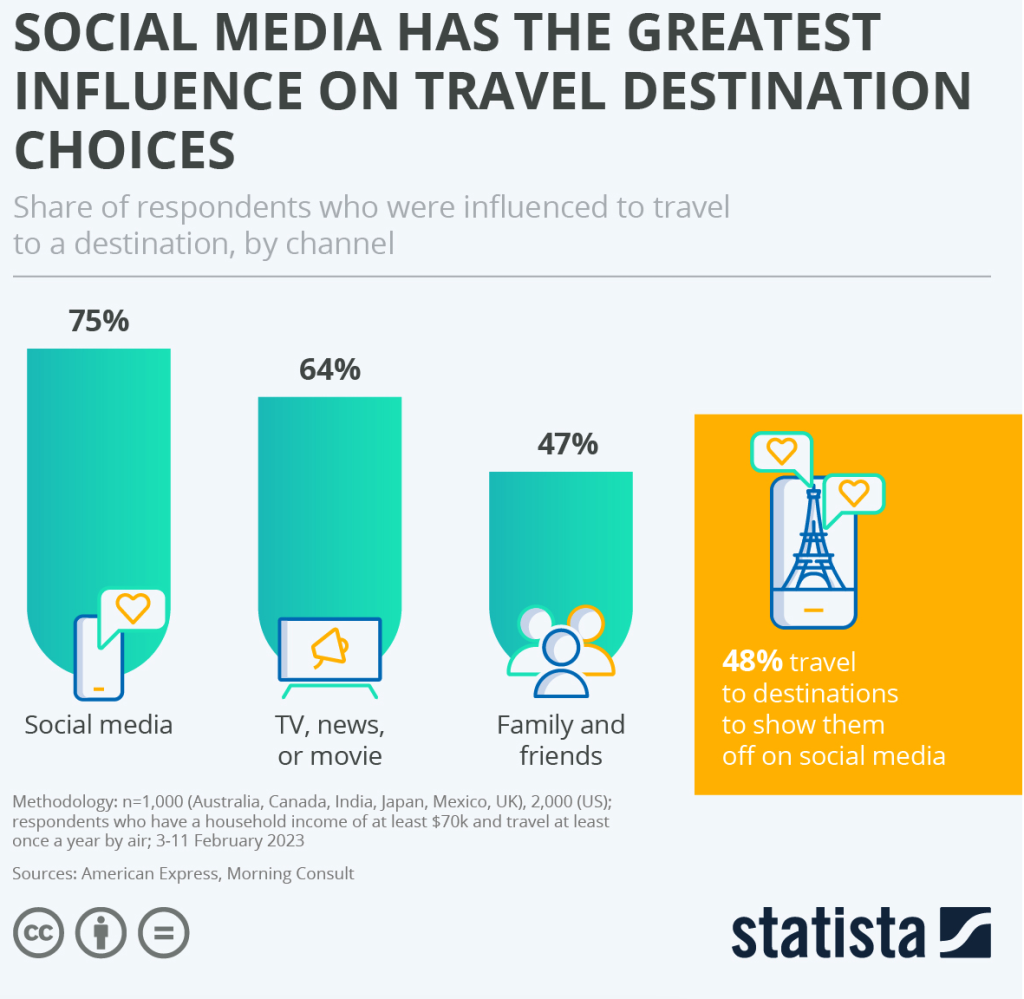
Source: Statista
Having a social media marketing plan and a well-designed website has become more important to reach these markets. To help you do this, consult the CBI’s studies How to be a successful tourism company online and How to work with influencers.
Tips:
- You must be sustainable if you want to attract the European honeymoon market. Even if you cannot get certified as a sustainable operator, you should publish your sustainable actions on your website and be able to prove your claims. Study the CBI’s studies to help you on your sustainability journey: How to be a sustainable tourism business, Tips to go green and Tips to be socially responsible.
- To find out more about tourism trends, read the CBI study, What trends offer opportunities or post threats on the European outbound tourism market.
Acorn Tourism Consulting Limited carried out this study on behalf of CBI.
Please review our market information disclaimer.
Search
Enter search terms to find market research
